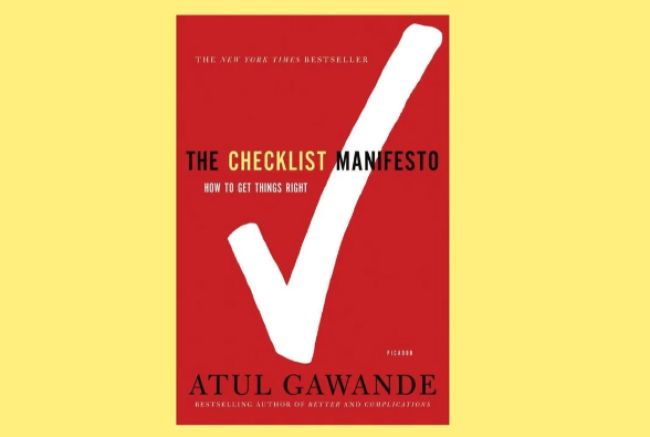
‘The Checklist Manifesto’ for High-Performing Fleet Professionals
As a fleet manager, ensuring efficiency and safety is paramount in your daily operations. But how can you effectively balance these priorities without sacrificing one for the other?
One solution may lie in an unlikely place: the checklist.
In “The Checklist Manifesto: How to Get Things Right,” surgeon and Harvard Medical School professor Atul Gawande breaks down how checklists can reduce errors and improve outcomes in various industries, including health care, aviation and construction.
But you can also apply the same principles to fleet management – to prevent costly spec’ing and ordering mistakes and keep technicians safe as they work on and around heavy vehicles.
How? Follow these seven takeaways with key quotes from Gawande’s book.
1. Prioritize creating checklists.
“Under conditions of complexity, not only are checklists a help, they are required for success.”
By providing a structured approach that reminds individuals of important tasks or considerations, checklists can help ensure that all team members don’t miss critical steps, especially in complex and high-pressure environments.
2. Cover all your bases.
“Checklists seem able to defend anyone, even the experienced, against failure in many more tasks than we realized. They provide a kind of cognitive net. They catch mental flaws inherent in all of us – flaws of memory and attention and thoroughness.”
Gawande argues that checklists can be effective in protecting you and your team, even those with a lot of experience, from making mistakes. The reason is that checklists provide a “cognitive net” that can catch mental errors common to everyone, such as forgetting important details, losing focus or not being thorough enough.
3. Understand what checklists are – and aren’t.
“It is common to misconceive how checklists function in complex lines of work. They are not comprehensive how-to guides, whether for building a skyscraper or getting a plane out of trouble. They are quick and simple tools aimed to buttress the skills of expert professionals. And by remaining swift and usable and resolutely modest, they are saving thousands upon thousands of lives.”
Create checklists for your team’s most critical repeatable processes, such as vehicle inspections and maintenance. But keep them modest in scope so they’re easy to follow. Then regularly review and update your checklists to ensure they remain current and relevant.
4. Be concise.
“The checklist cannot be lengthy. A rule of thumb some use is to keep it to between five and nine items, which is the limit of working memory.”
When you keep the checklist to a manageable number of items, your team is more likely to retain and process the information effectively.
5. Strike the right balance.
“An inherent tension exists between brevity and effectiveness. Cut too much, and you won’t have enough checks to improve care. Leave too much in, and the list becomes too long to use.”
How can you ensure that your checklists are practical and easy to follow? Here are a few tips:
- Prioritize the most critical tasks. Not every task needs to be included in a checklist, so focus on the most important ones.
- Get input from your team. Since your team members are the ones who will be using the checklist, it’s essential to get their feedback on what to include and what to leave out.
- Test and refine. Once you’ve created a checklist, test it with your team and gather feedback. Use this feedback to make adjustments as necessary.
6. Allow for flexibility.
“You want people to make sure to get the stupid stuff right. Yet you also want to leave room for craft and judgment and the ability to respond to unexpected difficulties that arise along the way.”
Checklists should not be so rigid that they don’t allow for flexibility and adaptability. So, design them to help you and your team get the basics right. But also take into account the user’s discretion to adapt the checklist to specific situations.
7. Don’t view checklists as busy work.
“Just ticking boxes is not the ultimate goal here. Embracing a culture of teamwork and discipline is.”
Don’t view checklists as a form of trivial busy work but rather as a critical tool for achieving consistent team performance. By using checklists, your team can work together more effectively and ensure they don’t miss important steps that could lead to catastrophic and costly mistakes.
Atul Gawande Checklist
- What’s New in Truck and Van Upfits for 2023?
- Pitfalls to Avoid When Transitioning to a Fleet Management Information System
- Despite the Momentum for Electric Vehicles, the Future is Still Uncertain
- ATVs and UTVs: Minimizing the Hazards
- Work Truck Week 2023 Heads Back to Indy
- Spec’ing Truck-Mounted Air Compressors
- The Latest Developments in the Hydrogen Fuel-Cell Truck Market
- ‘The Checklist Manifesto’ for High-Performing Fleet Professionals
- 6 Lessons Learned (So Far) on the Fast Track to an All-Electric Fleet
- The State of Fleet Maintenance in 2023

